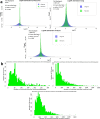Patterns of diverse gene functions in genomic neighborhoods predict gene function and phenotype
- PMID: 31863070
- PMCID: PMC6925100
- DOI: 10.1038/s41598-019-55984-0
Patterns of diverse gene functions in genomic neighborhoods predict gene function and phenotype
Abstract
Genes with similar roles in the cell cluster on chromosomes, thus benefiting from coordinated regulation. This allows gene function to be inferred by transferring annotations from genomic neighbors, following the guilt-by-association principle. We performed a systematic search for co-occurrence of >1000 gene functions in genomic neighborhoods across 1669 prokaryotic, 49 fungal and 80 metazoan genomes, revealing prevalent patterns that cannot be explained by clustering of functionally similar genes. It is a very common occurrence that pairs of dissimilar gene functions - corresponding to semantically distant Gene Ontology terms - are significantly co-located on chromosomes. These neighborhood associations are often as conserved across genomes as the known associations between similar functions, suggesting selective benefits from clustering of certain diverse functions, which may conceivably play complementary roles in the cell. We propose a simple encoding of chromosomal gene order, the neighborhood function profiles (NFP), which draws on diverse gene clustering patterns to predict gene function and phenotype. NFPs yield a 26-46% increase in predictive power over state-of-the-art approaches that propagate function across neighborhoods, thus providing hundreds of novel, high-confidence gene function inferences per genome. Furthermore, we demonstrate that copy number-neutral structural variation that shapes gene function distribution across chromosomes can predict phenotype of individuals from their genome sequence.
Conflict of interest statement
The authors declare no competing interests.
Figures






Similar articles
-
G-NEST: a gene neighborhood scoring tool to identify co-conserved, co-expressed genes.BMC Bioinformatics. 2012 Sep 28;13:253. doi: 10.1186/1471-2105-13-253. BMC Bioinformatics. 2012. PMID: 23020263 Free PMC article.
-
Clustering of gene ontology terms in genomes.Gene. 2014 Oct 25;550(2):155-64. doi: 10.1016/j.gene.2014.06.060. Epub 2014 Jul 1. Gene. 2014. PMID: 24995610
-
Chromosomal clustering of a human transcriptome reveals regulatory background.BMC Bioinformatics. 2005 Sep 19;6:230. doi: 10.1186/1471-2105-6-230. BMC Bioinformatics. 2005. PMID: 16171528 Free PMC article.
-
Ancient cis-regulatory constraints and the evolution of genome architecture.Trends Genet. 2013 Sep;29(9):521-8. doi: 10.1016/j.tig.2013.05.008. Epub 2013 Jun 18. Trends Genet. 2013. PMID: 23791467 Review.
-
Global analysis of bacterial transcription factors to predict cellular target processes.Trends Genet. 2004 Mar;20(3):126-31. doi: 10.1016/j.tig.2004.01.006. Trends Genet. 2004. PMID: 15049306 Review.
Cited by
-
Electrochemical Observation and pH Dependence of All Three Expected Redox Couples in an Extremophilic Bifurcating Electron Transfer Flavoprotein with Fused Subunits.JACS Au. 2025 Apr 7;5(4):1689-1706. doi: 10.1021/jacsau.4c01219. eCollection 2025 Apr 28. JACS Au. 2025. PMID: 40313841 Free PMC article.
-
Underpinning the molecular programming attributing heat stress associated thermotolerance in tea (Camellia sinensis (L.) O. Kuntze).Hortic Res. 2021 May 1;8(1):99. doi: 10.1038/s41438-021-00532-z. Hortic Res. 2021. PMID: 33931616 Free PMC article.
-
Noncontiguous operon atlas for the Staphylococcus aureus genome.Microlife. 2024 Mar 30;5:uqae007. doi: 10.1093/femsml/uqae007. eCollection 2024. Microlife. 2024. PMID: 38651166 Free PMC article.
-
Systematic analysis of the underlying genomic architecture for transcriptional-translational coupling in prokaryotes.NAR Genom Bioinform. 2022 Sep 27;4(3):lqac074. doi: 10.1093/nargab/lqac074. eCollection 2022 Sep. NAR Genom Bioinform. 2022. PMID: 36186922 Free PMC article.
-
Multi-tissue DNA methylation microarray signature is predictive of gene function.Epigenetics. 2022 Nov;17(11):1404-1418. doi: 10.1080/15592294.2022.2036411. Epub 2022 Feb 13. Epigenetics. 2022. PMID: 35152835 Free PMC article.
References
Publication types
MeSH terms
LinkOut - more resources
Full Text Sources

